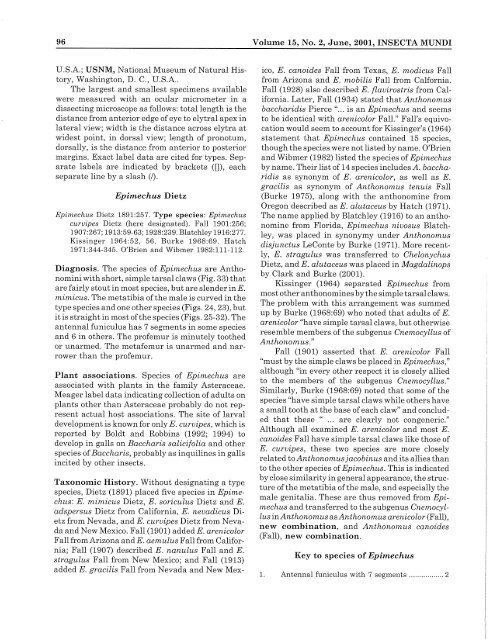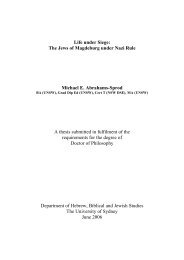Epimechus Dietz (Coleoptera: Curculionidae: Anthonomini)
Epimechus Dietz (Coleoptera: Curculionidae: Anthonomini)
Epimechus Dietz (Coleoptera: Curculionidae: Anthonomini)
You also want an ePaper? Increase the reach of your titles
YUMPU automatically turns print PDFs into web optimized ePapers that Google loves.
96<br />
U.S.A.; USNM, National Museum of Natural History,<br />
Washington, D. C., U.S.A..<br />
The largest and smallest specimens available<br />
were measured with an ocular micrometer in a<br />
dissecting microscope as follows: total length is the<br />
distance from anterior edge of eye to elytral apex in<br />
lateral view; width is the distance across elytra at<br />
widest point, in dorsal view; length of pronotum,<br />
dorsally, is the distance from anterior to posterior<br />
margins. Exact label data are cited for types. Separate<br />
labels are indicated by brackets ([]), each<br />
separate line by a slash (I).<br />
<strong>Epimechus</strong> <strong>Dietz</strong><br />
<strong>Epimechus</strong> <strong>Dietz</strong> 1891:257. Type species: <strong>Epimechus</strong><br />
curvipes <strong>Dietz</strong> (here designated). Fall 1901:256;<br />
1907:267; 1913:59-63; 1928:239. Blatchley 1916:277.<br />
Kissinger 1964:52, 56. Burke 1968:69. Hatch<br />
1971:344-345. O'Brien and Wibmer 1982:111-112.<br />
Diagnosis. The species of <strong>Epimechus</strong> are <strong>Anthonomini</strong><br />
with short, simple tarsal claws (Fig. 33) that<br />
are fairly stout in most species, but are slender in E.<br />
mimicus. The metatibia of the male is curved in the<br />
type species and one other species (Figs. 24, 23), but<br />
it is straight in most of the species (Figs. 25-32). The<br />
antennal funiculus has 7 segments in some species<br />
and 6 in others. The profemur is minutely toothed<br />
or unarmed. The metafemur is unarmed and narrower<br />
than the profemur.<br />
Plant associations. Species of <strong>Epimechus</strong> are<br />
associated with plants in the family Asteraceae.<br />
Meager label data indicating collection of adults on<br />
plants other than Asteraceae probably do not represent<br />
actual host associations. The site of larval<br />
development is known for only E. curvipes, which is<br />
reported by Boldt and Robbins (1992; 1994) to<br />
develop in galls on Baccharis salicifolia and other<br />
species of Baccharis, probably as inquilines in galls<br />
incited by other insects.<br />
Taxonomic History. Without designating a type<br />
species, <strong>Dietz</strong> (1891) placed five species in <strong>Epimechus</strong>:<br />
E. mimicus <strong>Dietz</strong>, E. soriculus <strong>Dietz</strong> and E.<br />
adspersus <strong>Dietz</strong> from California, E. nevadicus <strong>Dietz</strong><br />
from Nevada, and E. curuipes <strong>Dietz</strong> from Nevada<br />
and New Mexico. Fall (1901) added E. arenicolor<br />
Fall from Arizona and E. aemulus Fall from California;<br />
Fall (1907) described E. nanulus Fall and E.<br />
stragulus Fall from New Mexico; and Fall (1913)<br />
added E. gracilis Fall from Nevada and New Mex-<br />
Volume 15, No.2, June, 2001, INSECTA MUNDI<br />
ico, E. canoides Fall from Texas, E. modicus Fall<br />
from Arizona and E. mobilis Fall from Calfornia.<br />
Fall (1928) also described E. flauirostris from California.<br />
Later, Fall (1934) stated that Anthonomus<br />
baccharidis Pierce " ... is an <strong>Epimechus</strong> and seems<br />
to be identical with arenicolor Fall." Fall's equivocation<br />
would seem to account for Kissinger's (1964)<br />
statement that <strong>Epimechus</strong> contained 15 species,<br />
though the species were not listed by name. O'Brien<br />
and Wibmer (1982) listed the species of <strong>Epimechus</strong><br />
by name. Their list of 14 species includes A. baccharidis<br />
as synonym of E. arenicolor, as well as E.<br />
gracilis as synonym of Anthonomus tenuis Fall<br />
(Burke 1975), along with the anthonomine from<br />
Oregon described as E. alutaceus by Hatch (1971).<br />
The name applied by Blatchley (1916) to an anthonomine<br />
from Florida, <strong>Epimechus</strong> niuosus Blatchley,<br />
was placed in synonymy under Anthonomus<br />
disjunctus LeConte by Burke (1971). More recently,<br />
E. stragulus was transferred to Chelonychus<br />
<strong>Dietz</strong>, and E. alutaceus was placed in Magdalinops<br />
by Clark and Burke (2001).<br />
Kissinger (1964) separated <strong>Epimechus</strong> from<br />
most other anthonomines by the simple tarsal claws.<br />
The problem with this arrangement was summed<br />
up by Burke (1968:69) who noted that adults of E.<br />
arenicolor "have simple tarsal claws, but otherwise<br />
resemble members of the subgenus Cnemocyllus of<br />
Anthonomus."<br />
Fall (1901) asserted that E. arenicolor Fall<br />
"must by the simple claws be placed in <strong>Epimechus</strong>,"<br />
although "in every other respect it is closely allied<br />
to the members of the subgenus Cnemocyllus."<br />
Similarly, Burke (1968:69) noted that some of the<br />
species "have simple tarsal claws while others have<br />
a small tooth at the base of each claw" and concluded<br />
that these " ... are clearly not congeneric."<br />
Although all examined E. arenicolor and most E.<br />
canoides Fall have simple tarsal claws like those of<br />
E. curuipes, these two species are more closely<br />
related to Anthonomus jacobinus and its allies than<br />
to the other species of <strong>Epimechus</strong>. This is indicated<br />
by close similarity in general appearance, the structure<br />
ofthe metatibia ofthe male, and especially the<br />
male genitalia. These are thus removed from <strong>Epimechus</strong><br />
and transferred to the subgenus Cnemocyllus<br />
inAnthonomus asAnthonomus arenicolor (Fall),<br />
new combination, and Anthonomus canoides<br />
(Fall), new combination.<br />
Key to species of <strong>Epimechus</strong><br />
1. Antennal funiculus with 7 segments ................. 2
















